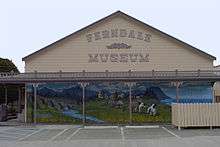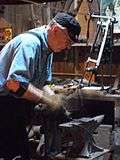Ferndale Museum
 The Shaw Street side of the Museum is muraled. | |
| Location | 515 Shaw Avenue, Ferndale, California |
|---|---|
| Type | history |
| Website | http://ferndale-museum.org/ |
Coordinates: 40°34′41.4″N 124°15′48.09″W / 40.578167°N 124.2633583°W The Ferndale Museum, located in Ferndale, California, houses and exhibits artifacts, documents and papers from settlement during the California Gold Rush to the present including an active Bosch-Omori seismograph. The area of collection covers the lower Eel River Valley as far south as the Mattole River Valley and west to the Pacific Ocean. Collections include over 6,000 photographs, back issues of the Ferndale Enterprise newspaper, and family papers spanning 140 years.
Exhibits

Permanent displays in the main building include a Magneto switchboard, a Pacific Telephone toll board, working crank telephones, historical rooms and furnishings, doll houses of interesting local buildings,[1] and a display of Seth Kinman items. Tools, dairy, logging and farm equipment and a working blacksmith forge are in the museum Annex.[1]
Bosch-Omori Seismograph
Ferndale resident Joseph Jordan Bognuda (2 October 1889 Vacaville, California - 7 January 1979) became interested in earthquakes after living through the 1906 San Francisco which caused considerable damage in Ferndale and over the entire Eel River Valley.[2] Bognuda began a correspondence with Perry Byerly and attended lectures at the University of California at Berkeley which resulted in the University and the U.S. Coast and Geodetic Survey establishing a Ferndale Seismographic Station with a lighter Bosch-Omori Seismograph than the one in active use at Berkeley at the same time.[3]
Omori Seismographs were developed by Fusakichi Omori, a seismologist at the Imperial University of Tokyo and further refined by J.A. Bosch of Strasbourg who added a damping mechanism.[4]
Bosch-Omori Seismographs are made of two units, one to detect movement North to South and the other East to West. Each has a pendulum which can pivot, restrained by a flexible wire and have a recording needle which traces on smoked paper, controlled by a weight-powered timepiece.[5]
The seismograph parts were shipped from Berkeley to Ferndale and assembled by Bognuda and Horace Winslow of the U.S. Coast and Geodetic Survey in what is now the Ferndale Fire Department building.[2] This new Ferndale Station, abbreviated "FER" - located at 40°34′33.74″N 124°15′48.92″W / 40.5760389°N 124.2635889°W - became active on January 25, 1933.[3]
During the nearly 30 years FER station was in operation,[6] newspapers throughout the U.S. contacted it for information about California earthquakes.[7] With daily observations, Bognuda solved an old puzzle about constantly wiggling traces, by correlating vibrations recorded at FER station to heavy surf on the nearby coast,[8] an effect now called wave-generated microseism.[9]
The FER station became inactive in 1962 when advances in seismic technology rendered it and several others in the state obsolete.[3] The Bosch-Omori seismograph was donated to Ferndale by the University,[5] and moved to the Museum where it continues to record daily.[2]
Ferndale Museum Mural
In 2007, artists collective Empire Squared of Eureka, California donated labor to paint a mural featuring local history and scenery on the Shaw Street side of the museum.[10]
References
- 1 2 McKowen, Ken; Dahlynn McKowen (September 2006). Best of California's Missions, Mansions, and Museums: A Behind-the-Scenes Guide to the Golden State's Historic and Cultural Treasures. Wilderness Press. p. 344. ISBN 978-0-89997-398-2.
- 1 2 3 Smith, Paul R. (December 2009). "History of the Ferndale Seismograph". The Ferndale Museum. Retrieved 6 April 2011.
- 1 2 3 Litehiser, Joe J., editor (1989). Observatory Seismology: A Centennial Symposium for the Berkeley Seismographic Stations. Berkeley, California: University of California Press. p. 379.
- ↑ Clancey, Gregory K. (2006). Earthquake nation: the cultural politics of Japanese seismicity, 1868-1930. Berkeley, California: University of California Press. p. 331. ISBN 978-0-520-24607-2.
- 1 2 Poppe, Barbara B. (1979). Historical Survey of U.S. Seismograph Stations: Geological Survey Professional Paper 1096, Department of the Interior. Washington DC: United States Government Printing Office. p. 390.
- ↑ Byerly, Perry (1937). "Earthquakes off the coast of northern California". Seismological Society of America Bulletin. 25: 73–96.
- ↑
- "California Earthquake". Niagara Falls Gazette, Niagara Falls, NY. December 18, 1946. p. 1.
- ↑ Louderback, George D. (July 1942). "History of the University of California Seismographic stations and related activities". Seismological Society of America Bulletin. 32 (3): 205–229.
- ↑ Dengler, Lori; G. Carver; R. McPherson (1992). "Sources of north coast seismicity". California Geology, California Division of Mines and Geology. March/April (45): 40–53.
- ↑ Bruce, Kevin (June 2009). Large Art in Small Places: Discovering the California Mural Towns. Ten Speed Press. p. 192. ISBN 978-1-58008-880-0.